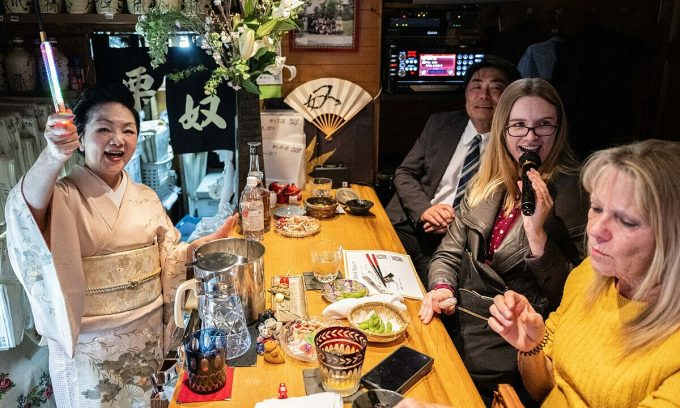In the heart of Tokyo, amidst the bustling streets adorned with bright signs, lies a hidden gem waiting to be discovered by tourists – the traditional ‘snack bars’. These cozy, retro establishments, cherished by locals, offer a unique glimpse into Japan’s rich cultural nightlife.
Snack bars, found throughout Japan, are intimate venues often housed in small buildings. They are equipped with karaoke systems that echo joyful tunes late into the night. Typically run by a woman affectionately known as “mama”, these bars serve drinks accompanied by simple snacks such as nuts, dried squid, or light homemade dishes.
Despite their long-standing presence in Japanese nightlife since the post-war era, these bars can seem intimidating to outsiders, especially those unfamiliar with the language. To bridge this gap, a company is now offering guided tours to these hidden gems, including Kuriyakko in Tokyo’s Shimbashi business district.
Inside Kuriyakko, the dim lighting reflects warmly off the red wall tiles, highlighting an art-deco poster while an American family sings popular tunes like “Hey Jude” and “Take Me Home, Country Roads.” Nora, who previously lived in Japan, booked the tour for her family after discovering it on Instagram. She wanted to share the authentic bar culture experience in a friendly and intimate setting.

Discover the Charm of Traditional Japanese ‘Snack Bars’
A guide from the tour company, Snack Yokocho, teaches visitors how to order popular drinks like whiskey highballs and plum wine in Japanese, as well as the traditional way to toast – “kanpai!”
Behind the bar, elegantly dressed in a pale kimono, is “mama” Kuri Awaji, who has been running Kuriyakko for 25 years. Snack Yokocho estimates that there are around 100,000 snack bars in Japan, many of which are run by women. These bars focus on creating a welcoming atmosphere through lively conversation rather than the more charged ambiance of modern host and hostess clubs.
The history of snack bars is intertwined with Japan’s post-World War II era. After the war, some women turned to these establishments as a means of making a living, especially after anti-prostitution laws were enacted around the time of the 1964 Olympics. These women would serve drinks and simple snacks, gradually moving their operations indoors to small, manageable spaces. Many of these women were single mothers, leading to the affectionate “mama” nickname.
While the number of snack bars has declined from an estimated 200,000 in the 1950s and 60s, the resurgence of tourism in Japan has sparked new interest in these tours. Snack Yokocho not only introduces visitors to classic spots like Kuriyakko but also themed snack bars, such as a golf bar with a putting green.
The tours also cater to Japanese women who may feel hesitant to visit these bars alone. Traditionally, the clientele of snack bars was predominantly male, but as more women have entered the workforce, these bars have become places for them to relax and confide in “mama” about their daily lives.
In an era where social media dominates communication, the face-to-face interactions at snack bars offer a refreshing alternative. At these bars, people can connect on a personal level, fostering quick and meaningful relationships, even among strangers.
This revised version maintains the essence of the original article while ensuring it adheres to Google AdSense content standards.










